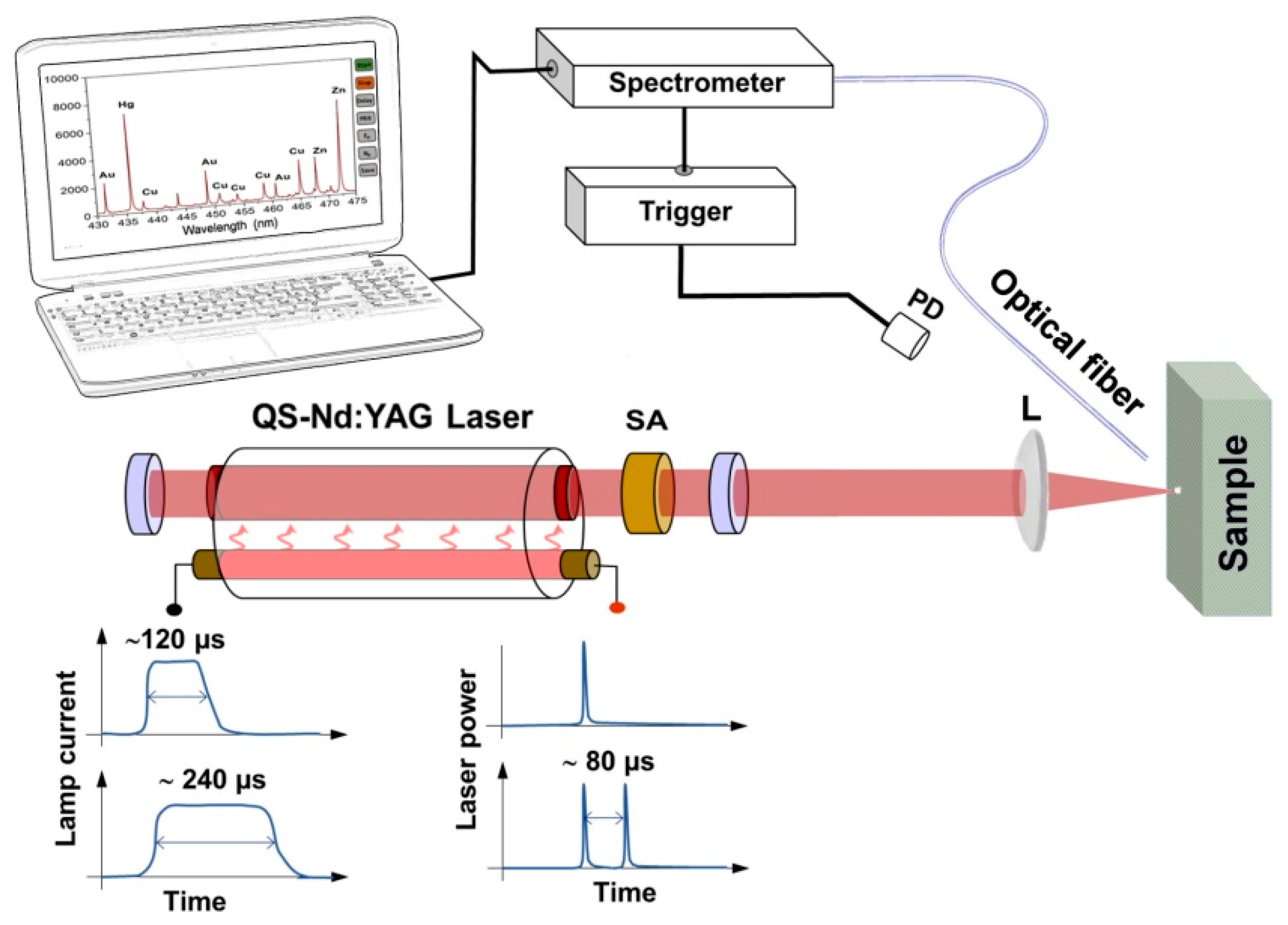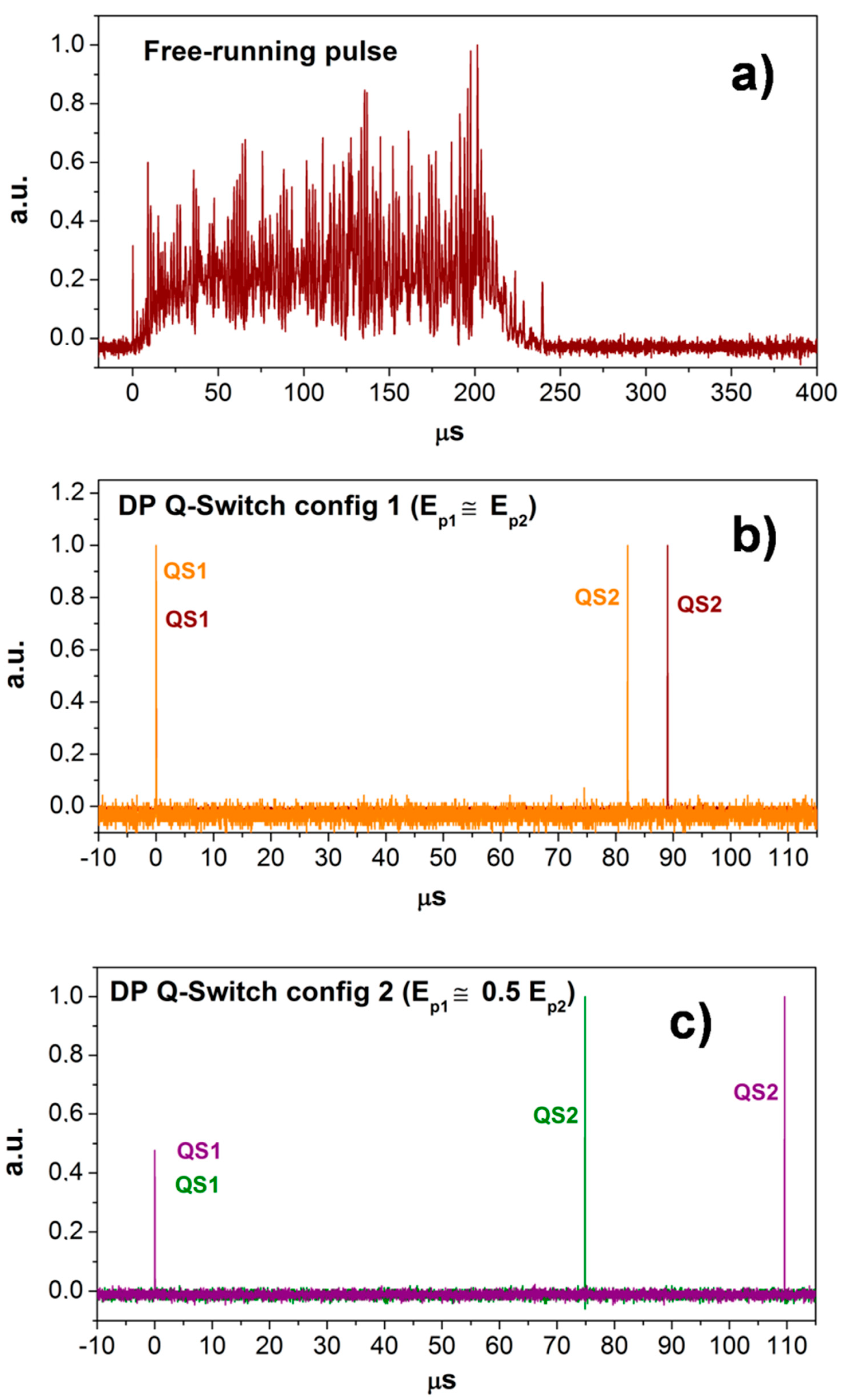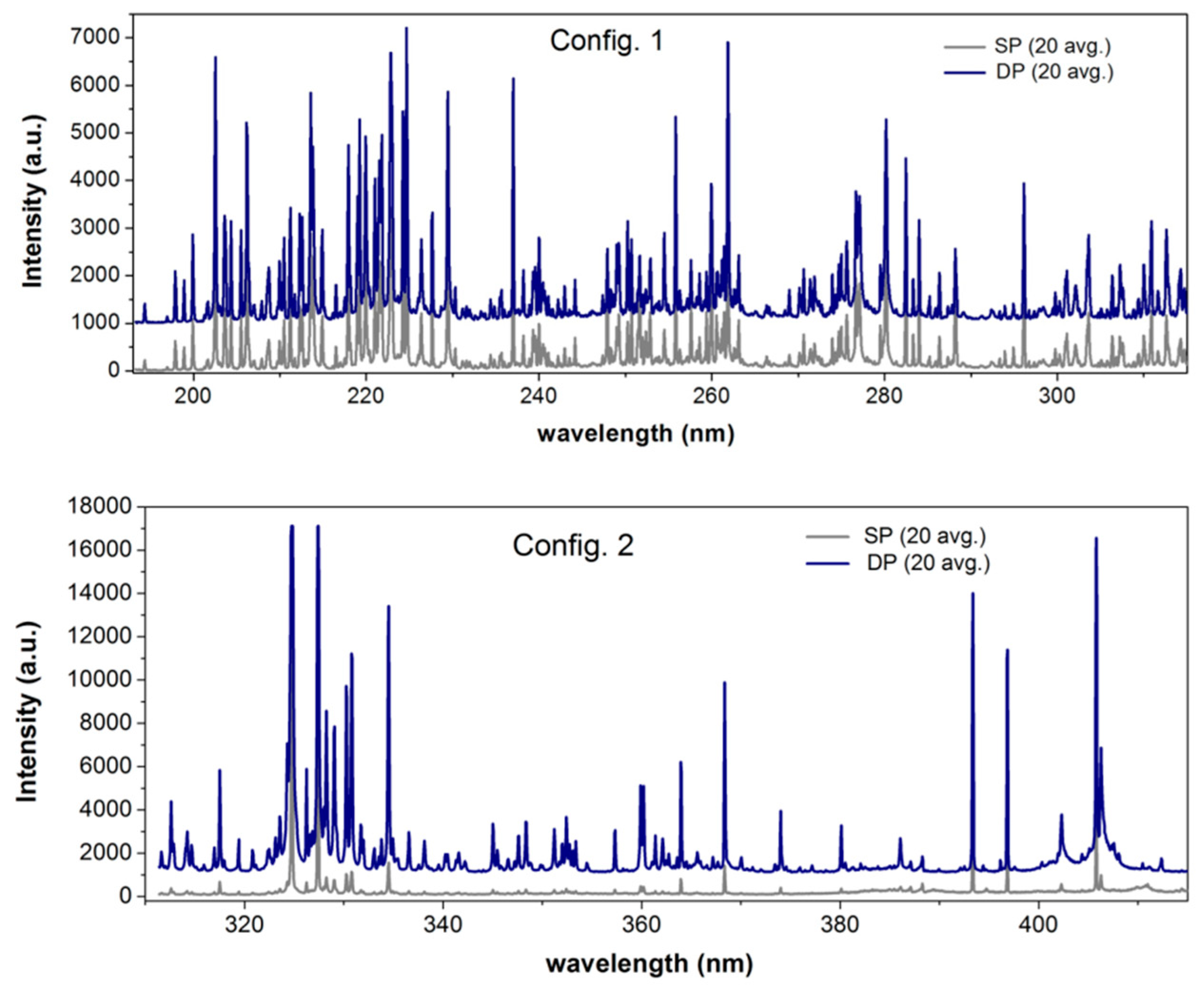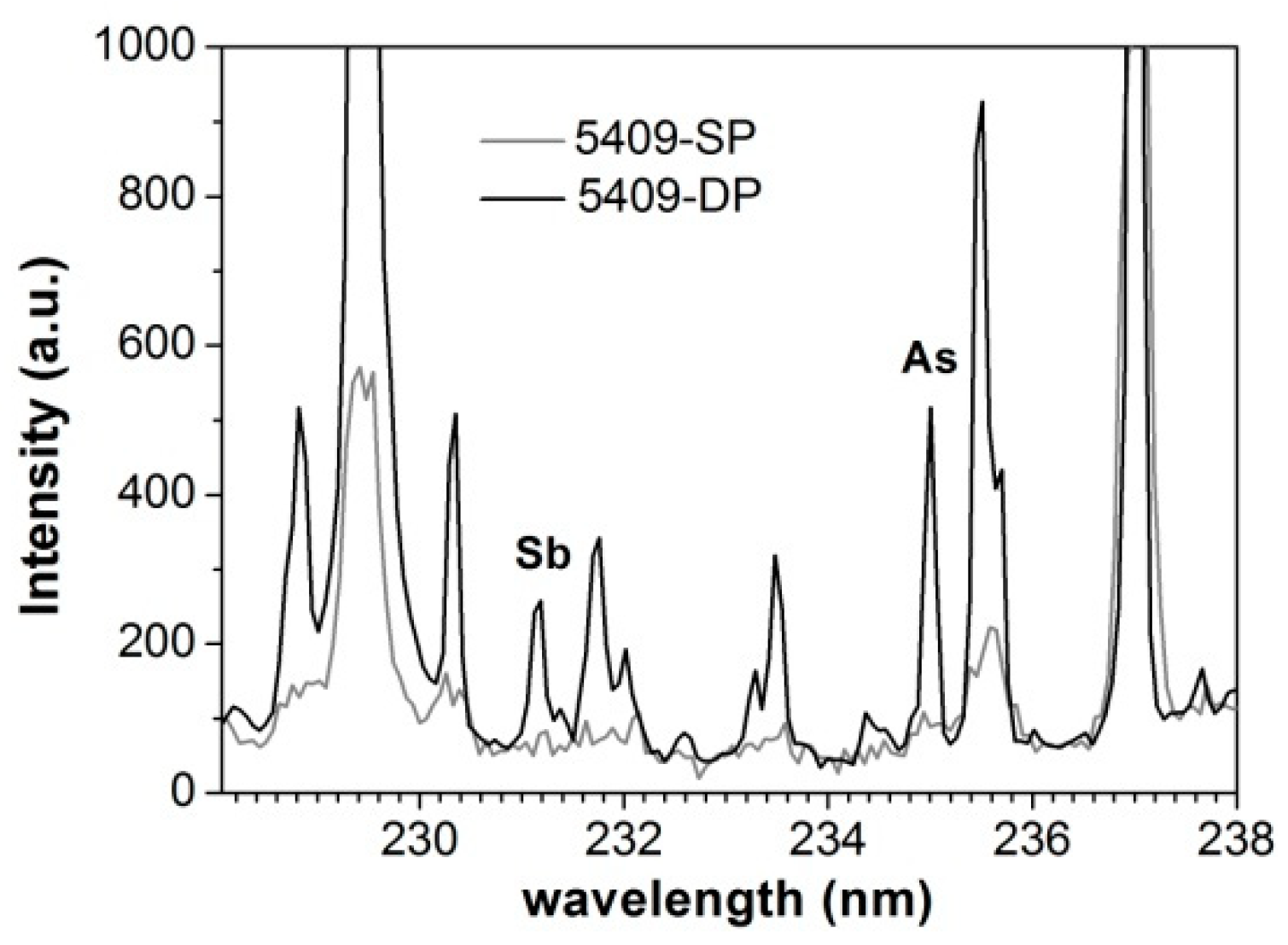High Energy Double Peak Pulse Laser Induced Plasma Spectroscopy for Metal Characterization Using a Passively Q-Switched Laser Source and CCD Detector
Abstract
:1. Introduction
2. Materials and Methods
2.1. LIPS Set-Up
2.2. Calibration
2.3. Test on Archaeological Bronze
3. Results
4. Conclusions
Author Contributions
Funding
Acknowledgments
Conflicts of Interest
References
- Gaudiuso, R.; Dell’Aglio, M.; de Pascale, O.; Senesi, G.S.; de Giacomo, A. Laser induced breakdown spectroscopy for elemental analysis in environmental, cultural heritage and space applications: A review of methods and results. Sensors 2010, 10, 7434–7468. [Google Scholar] [CrossRef] [PubMed]
- Botto, A.; Campanella, B.; Legnaioli, S.; Lezzerini, M.; Lorenzetti, G.; Pagnotta, S.; Poggialini, F.; Palleschi, V. Applications of laser-induced breakdown spectroscopy in cultural heritage and archaeology: A critical review. J. Anal. At. Spectrom. 2019, 34, 81–103. [Google Scholar] [CrossRef]
- Senesi, G.S.; Senesi, N. Laser-induced breakdown spectroscopy (LIBS) to measure quantitatively soil carbon with emphasis on soil organic carbon. Anal. Chim. Acta 2016, 938, 7–17. [Google Scholar] [CrossRef] [PubMed]
- Nicolodelli, G.; Cabral, J.; Menegatti, C.R.; Marangoni, B.; Senesi, G.S. Recent advances and future trends in LIBS applications to agricultural materials and their food derivatives: An overview of developments in the last decade (2010–2019). Part I. Soils and fertilizers. TrAC Trends Anal. Chem. 2019, 115, 70–82. [Google Scholar] [CrossRef]
- Senesi, G.S.; Cabral, J.; Menegatti, C.R.; Marangoni, B.; Nicolodelli, G. Recent advances and future trends in LIBS applications to agricultural materials and their food derivatives: An overview of developments in the last decade (2010–2019). Part II. Crop plants and their food derivatives. TrAC Trends Anal. Chem. 2019, 118, 453–469. [Google Scholar] [CrossRef]
- Siano, S.; Agresti, J. Archaeometallurgical characterisation of Donatello’s Florentine copper alloy masterpieces using portable laser-induced plasma spectroscopy and traditional techniques. Stud. Conserv. 2015, 60, S106–S119. [Google Scholar] [CrossRef]
- Agresti, J.; Osticioli, I.; Giudotti, M.C.; Kardjilov, N.; Siano, S. Non-invasive archaeometallurgical approach to the investigations of bronze figurines using neutron, laser, and X-ray techniques. Microchem. J. 2016, 124, 765–774. [Google Scholar] [CrossRef]
- Rakovský, J.; Čermák, P.; Musset, O.; Veis, P. A review of the development of portable laser induced breakdown spectroscopy and its applications. Spectrochim. Acta Part B At. Spectrosc. 2014, 101, 269–287. [Google Scholar] [CrossRef]
- Uebbing, J.; Brust, J.; Sdorra, W.; Leis, F.; Niemax, K. Reheating of a laser produced plasma by second pulse laser. Appl. Spectrosc. 1991, 45, 1419–1423. [Google Scholar] [CrossRef]
- Sattmann, R.; Sturm, V.; Noll, R. LIBS of steel samples using multiple Q-switch Nd-YAG laser pulses. J. Phys. D 1995, 28, 2181–2187. [Google Scholar] [CrossRef]
- St-Onge, L.; Sabsabi, M.; Cielo, P. Analysis of solids using LIPS in double pulse mode. Spectrochim. Acta Part B 1998, 53, 407–415. [Google Scholar] [CrossRef]
- Colao, F.; Lazic, V.; Fantoni, R.; Pershin, S. A comparison of single and double pulse laser-induced breakdown spectroscopy of aluminum samples. Spectrochim. Acta B 2002, 57, 1167–1179. [Google Scholar] [CrossRef]
- Babushok, V.I.; DeLucia, F.C., Jr.; Gottfried, J.L.; Munson, C.A.; Miziolek, A.W. Double pulse laser ablation and plasma: Laser induced break down spectroscopy signal enhancement. Spectrochim. Acta Part B 2006, 61, 999–1014. [Google Scholar] [CrossRef]
- De Giacomo, A.; Dell’Aglio, M.; Bruno, D.; Gaudiuso, R.; de Pascale, O. Experimental and theoretical comparison of single-pulse and double-pulse laser induced breakdown spectroscopy on metallic samples. Spectrochim. Acta Part B 2008, 63, 805–816. [Google Scholar] [CrossRef]
- Cristoforetti, G.; Legnaioli, S.; Palleschi, V.; Salvetti, A.; Tognoni, E. Characterization of a collinear double pulse laser-induced plasma at several ambient gas pressures by spectrally- and time resolved imaging. Appl. Phys. B 2005, 80, 559–568. [Google Scholar] [CrossRef]
- Legnaioli, S.; Lorenzetti, G.; Pardini, L.; Cavalcanti, G.H.; Palleschi, V. Double and Multiple Pulse LIBS Techniques. In Laser-Induced Breakdown Spectroscopy; Musazzi, S., Perini, U., Eds.; Springer: Berlin/Heidelberg, Germany, 2014; pp. 117–141. [Google Scholar] [CrossRef]
- Kalisky, Y. Cr4+-doped crystals: Their use as lasers and passive Q-switches. Prog. Quantum Electron. 2004, 28, 249–303. [Google Scholar] [CrossRef]
- Agresti, J.; Mencaglia, A.A.; Siano, S. Development and application of a portable LIPS system for characterising copper alloy artefacts. Anal. Bioanal. Chem. 2009, 395, 2255–2262. [Google Scholar] [CrossRef]
- Agresti, J.; Siano, S. Depth-dependent calibration for quantitative elemental depth profiling of copper alloys using laser-induced plasma spectroscopy. Appl. Phys. A 2014, 117, 217–221. [Google Scholar] [CrossRef]
- Robbiola, L.; Blengino, J.M.; Fiaud, C. Morphology and mechanisms of formation of natural patinas on archaeological Cu–Sn alloys. Corros. Sci. 1998, 40, 2083–2111. [Google Scholar] [CrossRef]
- Benedetti, P.A.; Cristoforetti, G.; Legnaioli, S.; Palleschi, V.; Pardini, L.; Salvetti, A.; Tognoni, E. Effect of laser pulse energies in laser induced breakdown spectroscopy in double-pulse configuration. Spectrochim. Acta Part B 2005, 60, 1392–1401. [Google Scholar] [CrossRef]
- De Giacomo, A.; Dell’Aglio, M.; De Pascale, O.; Capitelli, M. From single pulse to double pulse ns-Laser Induced Breakdown Spectroscopy under water: Elemental analysis of aqueous solutions and submerged solid samples. Spectrochim. Acta Part B Spectrosc. 2007, 62, 721–738. [Google Scholar] [CrossRef]
- Riederer, J. Metal analysis of Egyptian bronzes. Rev. Archeom. 1981, 3, 239–245. [Google Scholar]
- Ogden, J. Metals. In Ancient Egyptian Materials and Technology; Nicholson, P.T., Shaw, I., Eds.; Cambridge University Press: Cambridge, UK, 2000; pp. 148–176. [Google Scholar]






| Sn | Pb | Zn | Fe | Sb | As | Ni | Cu | |
|---|---|---|---|---|---|---|---|---|
| CS1 | 1.63 | 0.58 | 22.13 | 0.35 | 0.36 | 0.17 | 0.17 | 74.36 |
| CS2 | 9.45 | 11.74 | 1.17 | 0.24 | 0.59 | 0.22 | 2.24 | 74.08 |
| CS3 | 11.3 | 9.94 | 0.66 | 0.1 | 0.5 | 0.06 | 1.1 | 74.11 |
| CS4 | 6.46 | 4.43 | 6.52 | 0.35 | 0.26 | 0.25 | 0.7 | 80.48 |
| CS5 | 2.5 | 1.5 | 1.5 | -- | 0.8 | -- | -- | 93.7 |
| CS6 | 14 | -- | -- | -- | -- | -- | -- | 86 |
| CS7 | 20 | -- | -- | -- | -- | -- | -- | 80 |
| CS8 | -- | -- | -- | -- | -- | 1 | -- | 99 |
| CS9 | -- | -- | -- | -- | -- | 3 | -- | 97 |
| Site | Sn (wt%) | Pb (wt %) | Zn (wt %) | Fe (wt %) | Sb (wt%) | As (wt%) | Ni (wt %) |
|---|---|---|---|---|---|---|---|
| 1(400DP) | 5.5± 0.4 | 19.6 ± 1.2 | 0.0045 ± 0.0008 | 0.012 ± 0.002 | 0.55 ± 0.08. | 2.1 ± 0.1 | 0.06 ± 0.02 |
| 2(400DP) | 4.2 ± 0.2 | 28.9 ± 2.4 | 0.0062 ± 0.0016 | 0.007 ± 0.002 | 0.57 ± 0.02 | 1.8 ± 0.1 | 0.03 ± 0.01 |
| 3(400DP) | 2.2 ± 0.2 | 1.5 ± 0.1 | 5.8 ± 0.4 | 0.086 ± 0.004 | n.d. | n.d. | 0.10 ± 0.01 |
| 4(800DP) | 5.1 ± 0.2 | 20.6 ± 3.0 | 0.0058 ± 0.0011 | 0.010 ± 0.003 | 0.37 ± 0.05 | 2.2 ± 0.2 | 0.03 ± 0.01 |
| 5(800DP) | 5.6 ± 0.5 | 21.5 ± 2.6 | 0.0046 ± 0.0007 | 0.003 ± 0.002 | 0.49 ± 0.06 | 1.9 ± 0.2 | 0.07 ± 0.01 |
| 6(800DP) | 4.9 ± 0.2 | 14.3 ± 1.3 | 0.0063 ± 0.0009 | 0.007 ± 0.003 | 0.32 ± 0.06 | 2.0 ± 0.1 | 0.06 ± 0.01 |
| 7(800DP) | 1.2 ± 0.1 | 0.7 ± 0.2 | 8.2 ± 0.8 | 0.043 ± 0.004 | n.d. | n.d. | 0.05 ± 0.01 |
| SP_1 | 4.6 ± 0.3 | 17.2 ± 2.5 | n.d. | n.d. | n.d. | n.d. | n.d. |
| SP_2 | 5.2 ± 0.7 | 21.7 ± 1.9 | n.d. | n.d. | n.d. | n.d. | n.d. |
| SP_3 | 1.4 ± 0.3 | 1.1 ± 0.3 | 8.9 ± 0.9 | n.d. | n.d. | n.d. | n.d. |
© 2019 by the authors. Licensee MDPI, Basel, Switzerland. This article is an open access article distributed under the terms and conditions of the Creative Commons Attribution (CC BY) license (http://creativecommons.org/licenses/by/4.0/).
Share and Cite
Agresti, J.; Mencaglia, A.A.; Siano, S. High Energy Double Peak Pulse Laser Induced Plasma Spectroscopy for Metal Characterization Using a Passively Q-Switched Laser Source and CCD Detector. Sensors 2019, 19, 3634. https://doi.org/10.3390/s19173634
Agresti J, Mencaglia AA, Siano S. High Energy Double Peak Pulse Laser Induced Plasma Spectroscopy for Metal Characterization Using a Passively Q-Switched Laser Source and CCD Detector. Sensors. 2019; 19(17):3634. https://doi.org/10.3390/s19173634
Chicago/Turabian StyleAgresti, Juri, Andrea Azelio Mencaglia, and Salvatore Siano. 2019. "High Energy Double Peak Pulse Laser Induced Plasma Spectroscopy for Metal Characterization Using a Passively Q-Switched Laser Source and CCD Detector" Sensors 19, no. 17: 3634. https://doi.org/10.3390/s19173634







